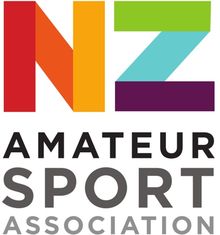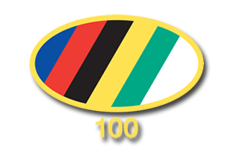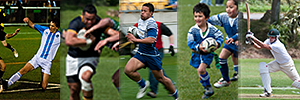Wellington's Ghost Rugby Clubs Part 6 – Brooklyn
Above: The Brooklyn Rugby Football Club Third-Grade team of 1954.
WELLINGTON’S “GHOST” RUGBY CLUBS
Part 6 – Brooklyn’s “Squabby Greeks”, “Teddy Roberts” And “Ashton Fitchett”
Known as “Wellington’s Salubrious Hill Suburb”, Brooklyn was formed 130 years ago in 1888, when 200 sections comprising “Goathurst Farm” (to the east of Ohiro Road), formerly owned by James Symons, were auctioned. Goathurst bordered “Fitchetts Farm” (to the west of Ohiro Road) part of which, the following year, was also sub-divided. The new suburb formed part of the Melrose Borough (which also included Kilbirnie and Island Bay) until it’s amalgamation into Wellington City in 1903.
Ashton Buddle Fitchett who inherited “Fitchetts Farm” from his father, saw the need for the fledgling Brooklyn community to establish its identity through sport, so in 1894 he became the Patron of the newly formed Brooklyn Football Club, (incorporating the Ohiro Football Club which had been formed at least two years earlier, in 1892). The new Club President was Edward Seagar, owner of the Victoria Foundry on Willis Street, the Club Captain was Fred Lingard (from Ohiro Football Club), with a number of the new Club Committee employees of Ashton Fitchett. The club, with the playing colours of red, white and black, practiced on Ohiro Road, where there was a small field near the Fitchett farmhouse.
The Brooklyn Club did not affiliate to the Wellington Rugby Union when formed, but joined the following year, albeit only briefly. In April 1895, the Wellington Rugby Union, Wellington Football Association, and Wellington Cricketers' Association, agreed “to protect one another's [financial] interests by refusing to allow any defaulting [non-paying] member to play under their jurisdiction until the amount owing [had] been paid to the Treasurer of the body to which he has been posted as a defaulter."

Brooklyn, along with a number of other cubs (as explained in Part 5 of this historical series) opted out, by forming the Wellington Junior Rugby Union, of which Brooklyn competed in the Senior Cup in 1895. That season the club’s single team played 10 games, winning 2 and finishing fifth out six teams in the Wellington Junior Rugby Union competition for the Wickens Cup. In 1896, while in a match against the Ferndale Football Club, “a boy named Emanuel Hendricksen, living at Brooklyn, was severely hurt. The upper part of his backbone [was] injured, and he was unconscious for some time”, the club didn’t compete in any Wellington competition.
Football continued to be played in Brooklyn over the next decade, mainly in the Public-School Competition with the Brooklyn School Football Club being formed in 1901. In 1905, Brooklyn re-formed and entered two teams in Wellington Rugby’s Fourth Grade Competition. The season was not particularly successful, with Brooklyn finishing toward the bottom of the 13-team table. The following year (1906) was more successful, with every member of the Brooklyn Club paying his subscription, (noted as something of a record in the era!) Under the watchful eye and coaching of former (1884) All Black half-back, Henry (“Harry”) Roberts, Brooklyn finished runners-up to St. James in the Fourth-Grade competition. The team won 14 of 17 games played, scoring 306 points and conceding only 30.
Roberts’ youngest son Edward (known as Teddy) was a member of the Brooklyn Club’s Fifth-Grade team, while his older brother Harry played in the Fourth-Grade side. The Roberts family lived at 26 Apuka Street and both Roberts boys attended Brooklyn School, playing in the Public Schools Competition. Harry was first selected to play for Wellington in 1909 and Teddy the following year. Teddy went on to become an All Black half-back in 1913, following in his father’s footsteps, playing 21 matches in his New Zealand career. Teddy Roberts also became a Wellington representative cricketer.
Joining Harry Roberts in the Fourth-Grade side of 1906 , were two sons of Richard Greeks, Claude and Raynor, (of 18 Hayes Street in Brooklyn) and their cousin Alfred, also former Brooklyn School pupils. Claude Greeks (known as “Squabby”, based on his short, stocky stature), was despite his nickname, noted as a “nippy and clever” player, going on to be selected to represent Wellington in 1908, at the young age of 18. Tragically, both Claude and Rayner were killed in action at Ypres in World War One, in October 1917.
The 1907 season started promisingly for the Club, with 13 new players and a decision to enter teams in the Junior Championship, as well as in the Third and Fourth Grade competitions. Arty Fullford, associated with the Melrose Club, was elected Club President and Richard Greeks the Club Captain, with the club’s gymnasium now located on Martin Square in Te Aro. The 1907 season was unsuccessful, however Claude Greeks received the award for “best working player on the field and most attentive patroniser of the gymnasium”.
In 1908, the club decided once again to enter a team in the Junior Championship, however in early April the club decided to resign from the Union, with the press noting that “the withdrawal of the club was stated to be due to lack of interest”. Arty Fullford took some players across to Melrose, while others joined St. James.
The second resurrection of the Brooklyn Club occurred in February 1924 at a meeting in Waldie’s Hall on Cleveland Street, chaired by George Slade, the publisher of the Rugby Union Annual, who lived on Ohiro Road. Using the Brooklyn school grounds, the Brooklyn United Rugby Football Club was re-affiliated to the Wellington Rugby Union in April 1924, although somewhat strangely, no teams ever took the field.
(In the early 1920’s George Slade was Chairman of the Management Committee and Trustee of the New Zealand Rugby Union, as well as being the Taranaki Rugby Union’s resident delegate in Wellington.)
The unsuccessful 1932 “Melwyn” merger which saw the Melrose-Selwyn rugby community disappear in 1936, meant that after World War Two, there was no rugby club representing Wellington’s southern hill suburbs. And so in 1948, the Brooklyn Rugby Football Club revived for the third time in its 54 year history, being re-admitted to the Wellington Union that year.
The club continued until at least 1956 playing in the third division of the Third-Grade Championship, but is assumed to have amalgamated or relapsed some time thereafter. Surprisingly, “Wellington’s Rugby History” makes no mention of Brooklyn RFC in this later era, merely noting that the 1924 club “did not last long”.
In 1913, the Evening Post noted that “the admiration for America and things American, which is affected in these parts (although not reciprocated in the States), may account for the naming of a suburb in a British possession after the big city opposite to New York.” Noting the impact that this small Wellington suburb had on the game in Wellington and New Zealand for over 60 years, in retrospect, Wellington’s rugby community can rightly display admiration for “things Brooklyn”.
Steven White, 19 Mar 2019
Adam Julian, 19 Mar 2019
Steven White, 12 Mar 2019
Adam Julian, 04 Mar 2019
Steven White, 12 Feb 2019








.jpg)






